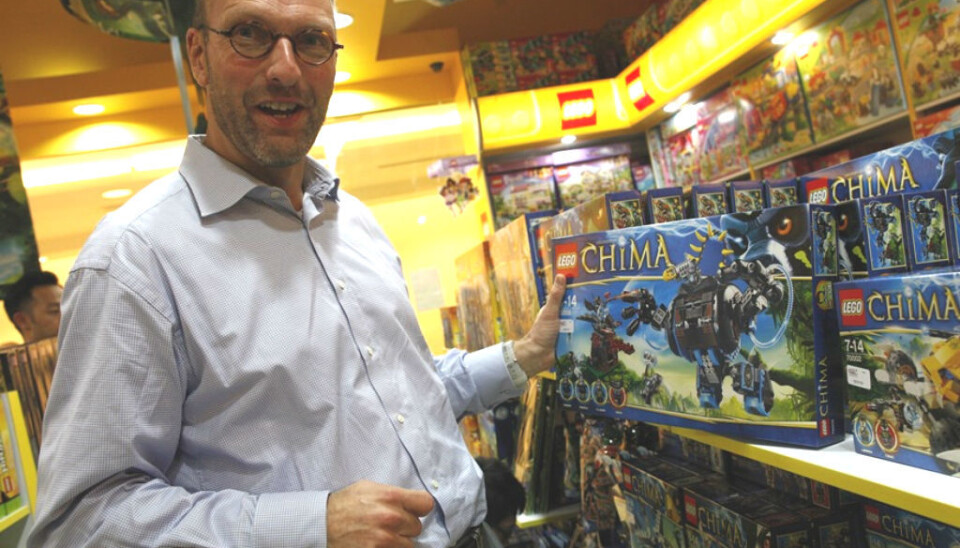An article from Buskerud and Vestfold University College (HBV)

Leaders cannot escape the past – for better or worse
At a time when things had gone very wrong, the LEGO Group got a chief executive officer who didn't know a lot about LEGO. By going back to square one, he found a way forward.
Denne artikkelen er over ti år gammel og kan inneholde utdatert informasjon.
Jørgen Vig Knudstorp was the first chief executive officer (CEO) of LEGO who was not a member of the company's founding family.
As the company was losing money and market share from a unfocused branding strategy, he set out to build a strategy on their traditional LEGO brick.
To find the way forward, he demanded the company to go back to square one. He asked a team or researchers at Massachusetts Institute of Technology (MIT) in Boston to investigate the virtues of the LEGO brick.
The process ended with the recognition that the brick was so unique, that it was impossible to ignore, but that the company could build on it and develop it further.
The rest is a story of unprecedented growth up till today.
Wisdom, patience and courage
“This is what new leaders can do, but it requires wisdom, patience and courage,” says Tor Hernes, professor of organization theory at Buskerud and Vestfold University College, Norway, and Copenhagen Business School, Denmark.
“Sometimes it may seem beneficial not to delve into with the past. However, the past will always catch up with you. So the question is which past you want to engage with,” he says.
Hernes is a leading figure in the emerging field of process thinking in organization studies, and has just published the book “A Process Theory of Organization” at Oxford University Press, and is also co-editor of the newly released “Oxford Handbook of Process Philosophy and Organization Studies”.
You can't escape history

Hernes believes LEGO is a very good example of an organization that connects with its own time, being conscious about it’s own past, it's own possible future and where the company is today.
“A new leader who will change an organization, must understand that you bring your own history with you, while you enter the organization's own time. If you fail, it may cause problems in the long term.”
The smartest thing a new leader can do, is to familiarize himself or herself with the organization and its history, according to the professor
“You can never escape the organization's own time. You can try to avoid it, but it will be on borrowed time.”
”Leaders who have failed before you, are also part of the organization's history. If you enter as leader number three, you should be careful, because the staff may not take you seriously. They will expect you to disappear again after a few years, as did the ones before you.”
Golden opportunity
This does not mean that you are doomed to failure as a new leader of an organization you do not know. Hernes explains that new leaders have a golden opportunity, in a short window of time after they have started.
“Just as a human can get a new perspective on his or her childhood, an organization can gain a new view of it's own history. This can happen through a new leader, who chooses to focus on elements of the history which have not been so clearly articulated earlier.”
Organizations change
The professor believes the literature on leadership has been too strongly influenced by western rationality thinking since the 60's. Organizations and institutions have been seen as entities, separate from the outside world, as stable things in a larger room, forced to adapt to changes in the room around.
But organizations change with the world around them, whether leaders want to or not.
Hernes thinks there is an underlying weakness in the organizational literature to assume that the world is in a stable condition, and that leading an organization is about matching this condition.
“When the condition changes, you must regroup to match the change. You end up running after, instead of being an active part of a world that is constantly changing,” he says.
A leader must instead stimulate the organization to deal with both past and future.
“To look to the past, does not in any way implicate to repeat it, but it is in the past that the seeds of an alternative future lies. The point is not to try and catch up with a static image of the world 'out there', but to understand the organization’s own movement in time.”
Using history during the financial crisis
During the financial crisis, economists looked to previous financial crises. This was how they could understand the context of institutions and regulatory regimes.
“The purpose was not to repeat earlier financial crises, but to understand the context of previous choices,” says Hernes.
“These are insights that go far back, both in philosophy, social science and natural science,” he adds.
Critical to management theories
Hernes is critical of much of today´s management theory, and says it has been too preoccupied with space, and has largely overlooked the importance of understanding time, especially understanding that managers and leaders exist in the flow of time from which they cannot escape.
“The defenders of these theories have not taken insights from either physics or philosophy in the last hundred years, which considers time to be a key factor. When I talk to business-leaders about the element of time, they don’t find it difficult to understand.”
The academics are the ones who sometimes have problems with it.
“Academics are trained in logic, and are used to putting phenomenon's in different boxes, to categorize and define questions and answers for each box. This works for room, but not for time, if time is to be able to play it´s role to the full,” says the professor.
Opportunities for change
He believes that this perspective gives organizations greater opportunities to take action on their own development.
“It is common to assume that the past is fixed, and that the future is open. My perspective is that the past is not fixed. By doing something about the future, we also do something about the past. Past and future are articulated in the present, they are inextricably linked to one another in the present time. This is where they interact and create opportunities for both change and continuity.”
Understanding the everyday dynamics
It is important to understand the dynamics that occur in those situations where people, ideas and technology meet. All these situations contribute into the organization's genesis and development.
“Because the world is constantly in motion, these situations will not have any influence if they are not repeated, reproduced and put in context with each other. And here lies one of the greatest challenges for those who want to lead an organization, namely to understand how situations are associated with each other over time,” says Hernes.
------------
Read the Norwegian version of this article at forskning.no






























